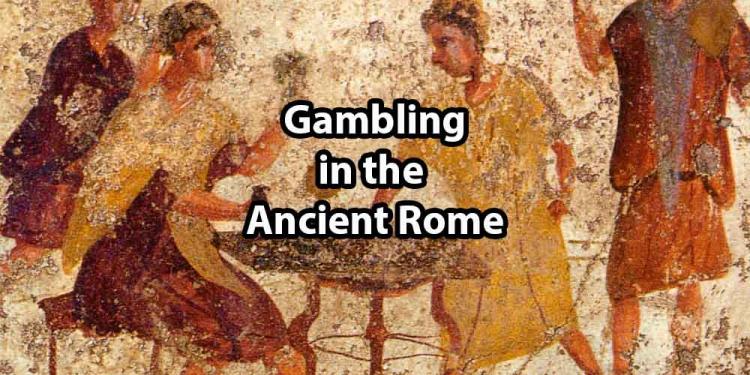Ancient Rome and Greece: Gambling Games
Posted: May 28, 2020
Updated: May 28, 2020
Since ancient man has been able to toss a few dinosaur knuckles on the ground, man has been gambling. Whether to please the Gods or correct the fates, man has always had a desire to both see into and stamp the mark of control onto the future. We can see his efforts in the illustrations and painting left from earlier times. In fact, there are a great number of art works that appertain to the Ancient Rome and Greece periods, where we can witness people playing gambling games. So just what games would they of played during this period?

Image source: WolfgangRieger via Wikimedia Commons
Gambling as a Popular Activity
During the period of Ancient Rome, members of all social classes, from slaves to the Emperors, took part in gambling games. In fact, you could say that their huge popularity could be considered an addiction by today’s standards. And it was common for inter-class play, whereby a soldier might have a flutter with a slave or a handicraft worker enjoy a punt with a Senator. Such was the power of the dice, those normal social boundaries fell by the wayside, in the attempts to win.
On the whole, it’s believed that gambling in Ancient Rome and Greece was a male pursuit, though that’s not to say that women of a higher class were forbidden to play. We do have records of women playing gambling games during festival holidays, such as the Bona Dea festival, where woman’s gambling was an especially organized event. Ancient Roman citizens would love the online casino sites in Italy, which are available anywhere, anytime.
Ancient Rome and Greece: The Most Popular Gambling Games
In Ancient Rome and Greece, there were really just two types of games to be played. One consisted of the throwing of dice alone, and the other was the same but with the use of aboard. This board consisted of 36 squares with various symbols on them, such as crosses, letters, numbers, and leaves. The dice were tossed three times and the luckiest throw was the combination of three sixes. This was essentially an earlier version of the game backgammon. In Ancient Rome the game was called “12 lines” or the “game of 12 signs”. The players used three dice, with each player having 15 goes.
The Game of Brigands
Another popular game in Ancient Rome and Greece was called “brigands”. This was a game of strategy and the markers were different colored pieces of glass. The winning player was the one who, rather as with chess, managed to capture the highest number of pieces. As the winner, he was proclaimed the “King”.

As well as using dice, knucklebones were also in common use. The origins of these games were connected to those using dice. Sophocles ascribes the invention of knucklebone to the mythical figure of Palamedes, who it was said, taught the game to his countrymen during the Trojan Wars. In fact, both Homers’ Iliad and the Odyssey contain allusions to the game of knucklebones. Pausanius made mention of these games as an offering of the Temple of Corinth, in his “Description of Greece”.
Click here to gamble like ancient romans at the King Billy Casino
Ancient Rome and Greece: 5 Knuckle Bones
These were used in two games. One was a game of skill involving the use of 5 knucklebones. Essentially these bones were thrown into the air, like the modern game of jacks, and caught in one hand on the way down. We can see the Goddesses Latona, Niobe, Phoebe, Aglaia and Hileaera, with the last two being engaged in playing a game of knucklebones, in a painting that was excavated from a house in Pompeii and can presently be found in the National Archaeological Museum of Naples. Going back even further, both Herodotus and Plato describe a foreign origin to the game. Plato, in Phaedrus, claims the Egyptian god Thoth as its inventor,
The Game of Tali
The other knuckle bone game, known as Tali, was one of chance. Players used 4 bones and consigned a value from 1 – 6 on each of them. Only the numbers 1, 3, 4, and 6 were marked on the pieces. These were simply thrown onto a surface with the highest score being deemed the winner. Though we call these games to knuckle bone games, this latter game utilized the short pastern bones from a sheep, goat, or a calf. These bones have two rounded ends, two broad and two narrow sides. One of these is concave (known as chips or “the dog”) and is scored as 1. The other side is convex and scores 3. Two more sides score a 4 and a 6.
There were a total of 35 different combinations of scores to be thrown. Many of these throws had their own distinctive names like Solon, Alexander, Midas, and Aphrodite. The Romans had their own names as well. These included Venus, King, and the Vulture. In Ancient Greece, the highest throw counted as 40 points and was called Euripides. In both Greece and Ancient Rome, the lowest throw was referred to as “the dog”.
Ancient Rome and Greece: Gambling Laws and Regulations
During both the Republican and Imperial periods of Ancient Rome, gambling was technically forbidden, apart from certain holidays and special occasions. One holiday that you could gamble freely on was the popular festival called Saturnalia, organized in honor of the god Saturn. During this period, everyone could gamble in public. And this is when it was common to see all classes gambling together at the same table.
On the whole, if you were to be caught gambling outside of these restricted times, then you could face a fine. But since when can a law stop a popular activity? In Ancient Rome and Greece gambling continued unabated in such places as taverns, houses, brothels, and frontier forts. It often inspired writers to remark on the weakness of the emperor’s towards the playing of games of chance. For both the Ancient Romans and the Greeks gambling games were and continue to be very much part of the social fabric of society.
Click here to visit the King Billy Casino












